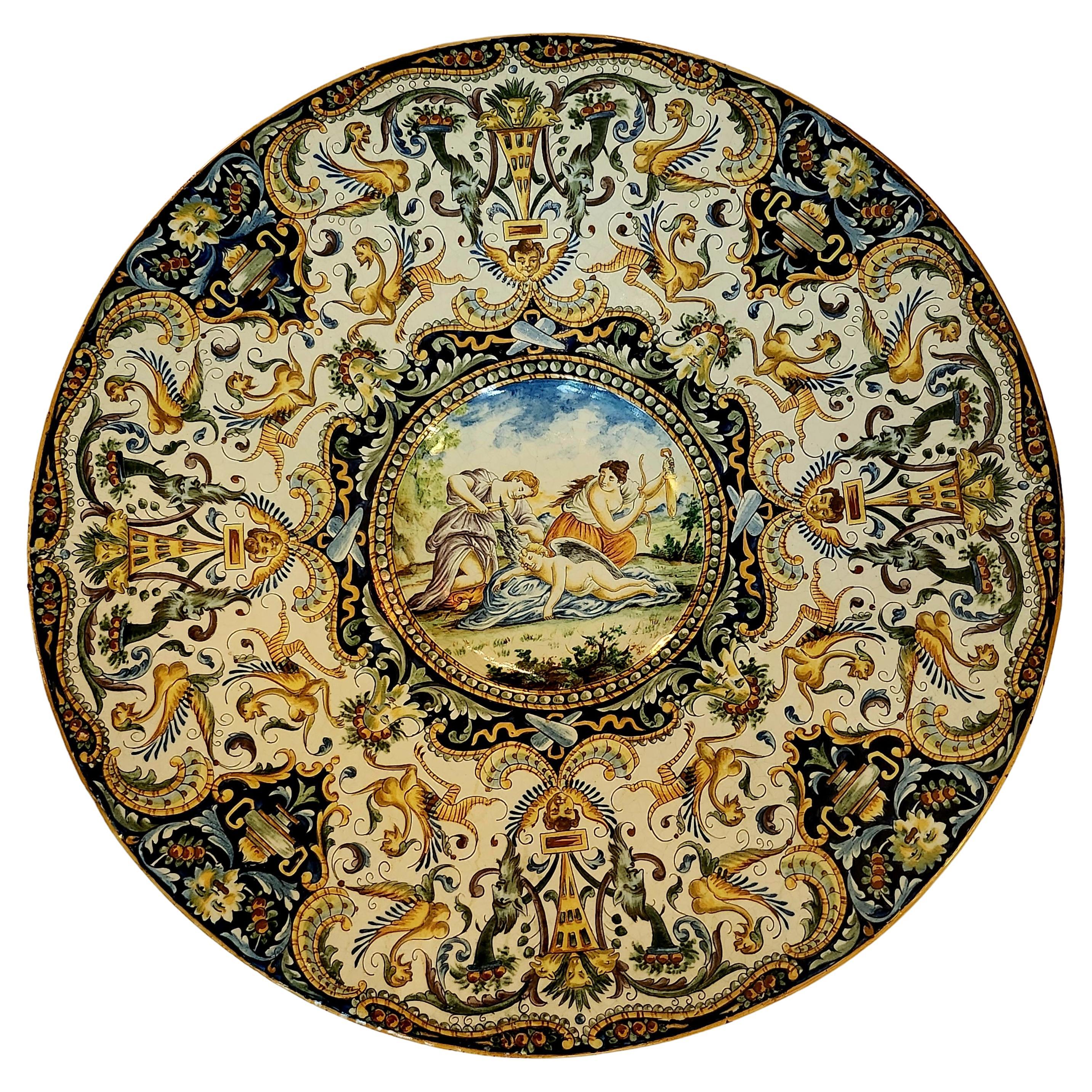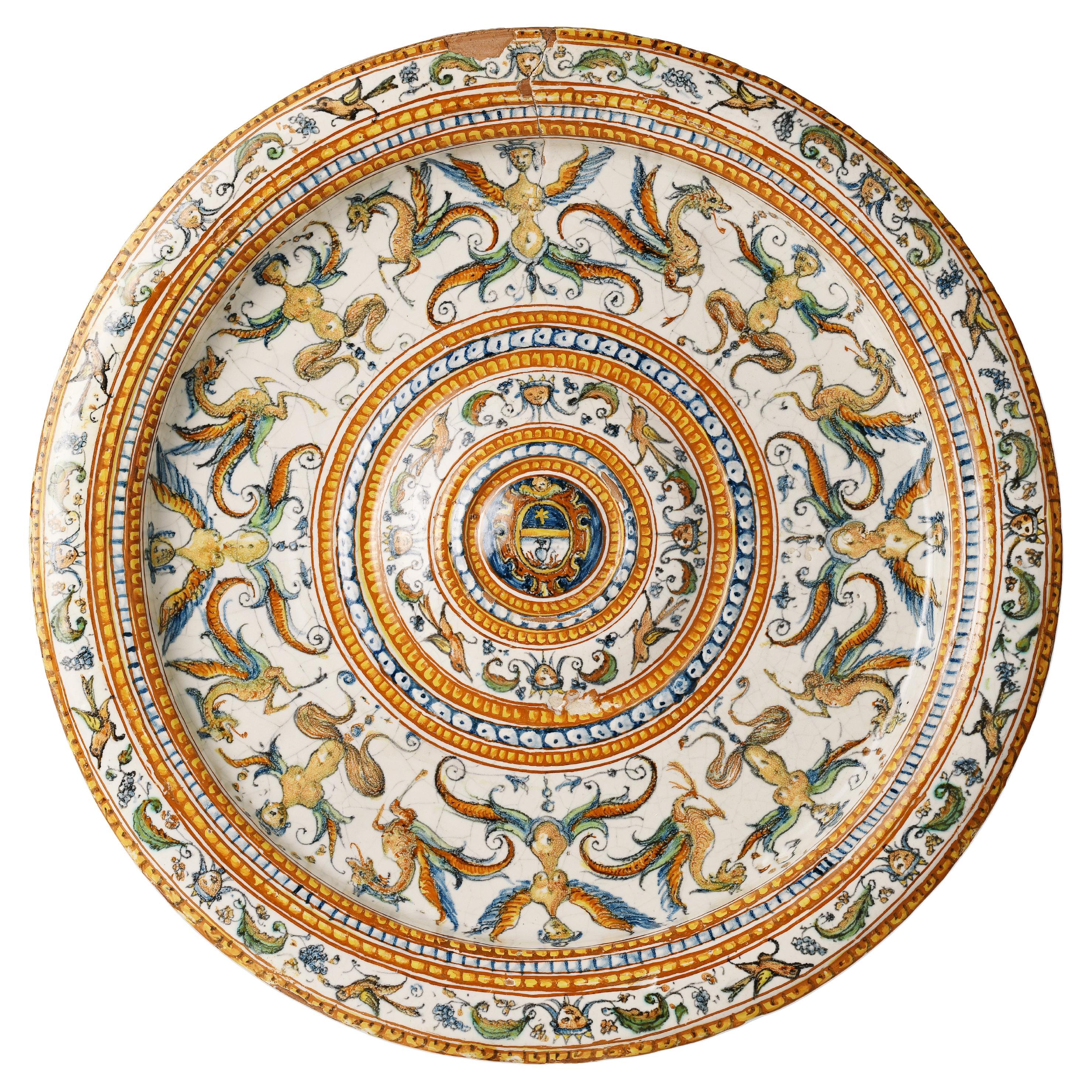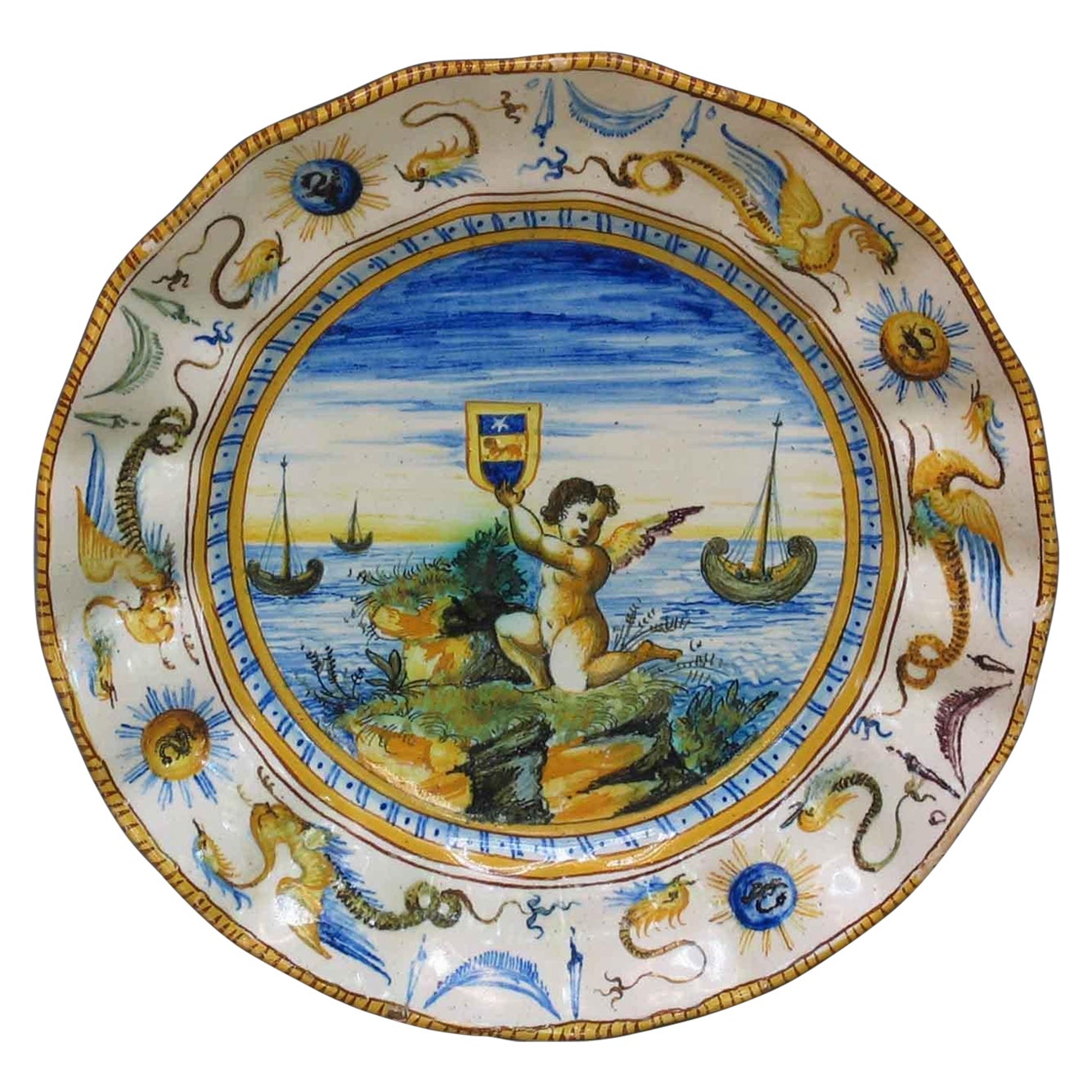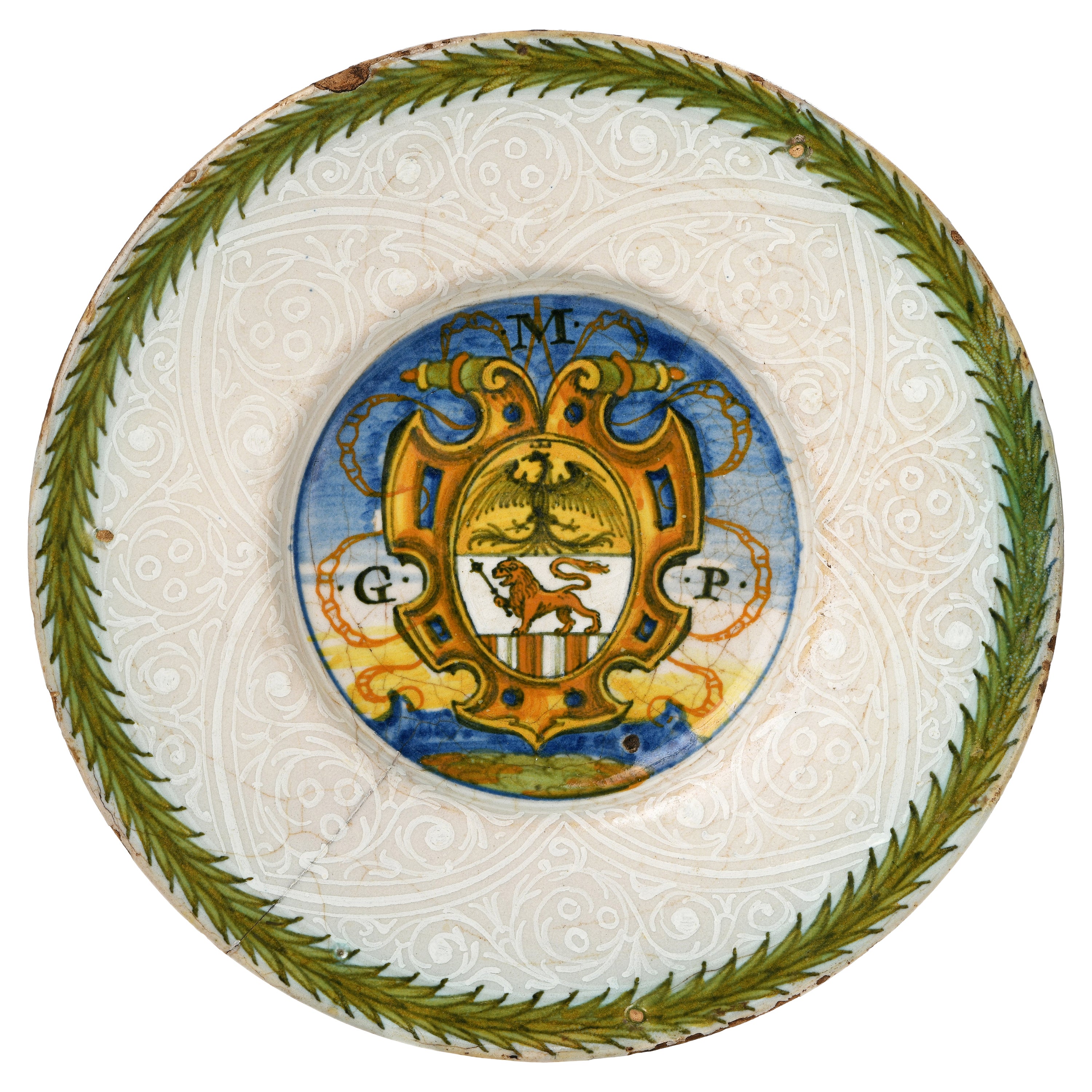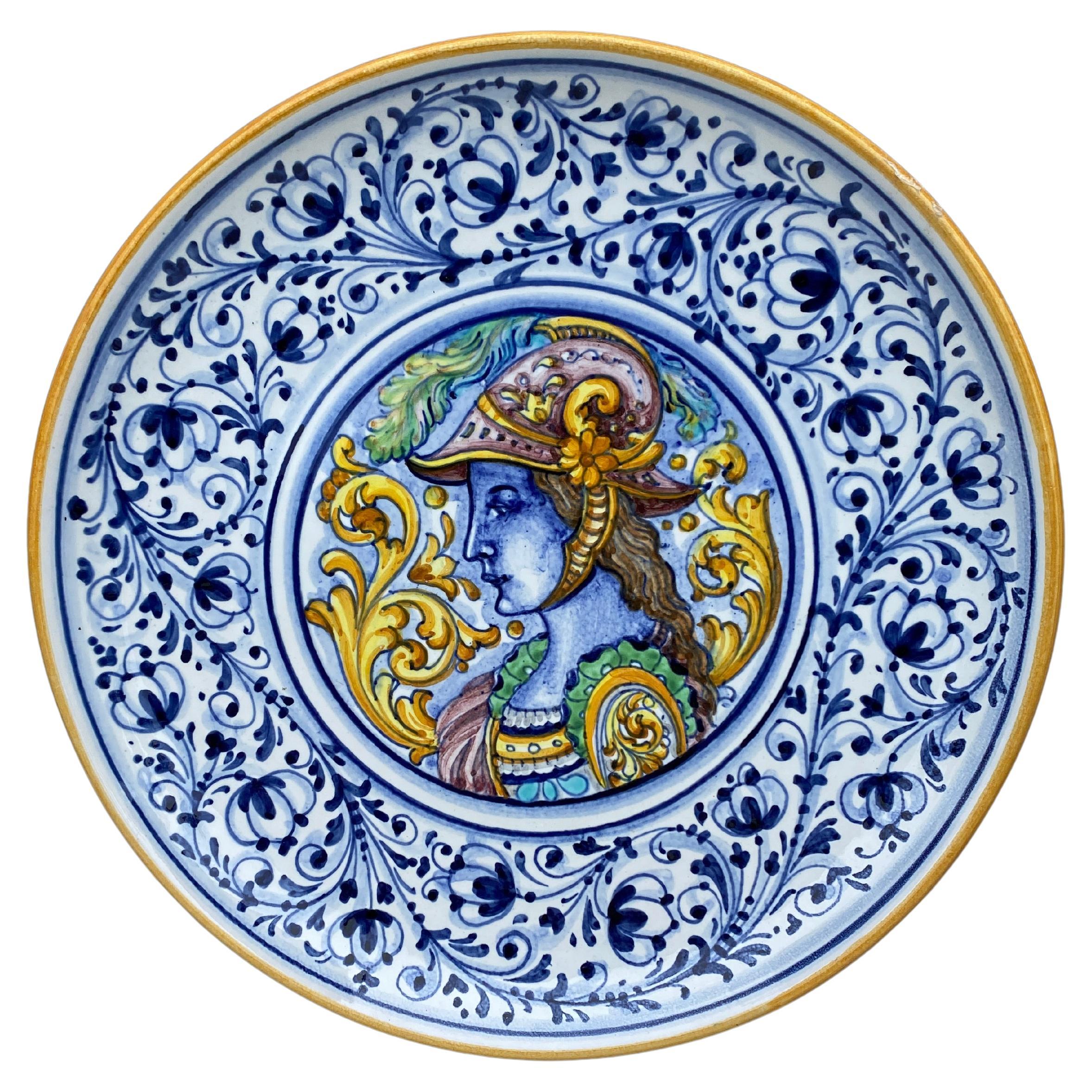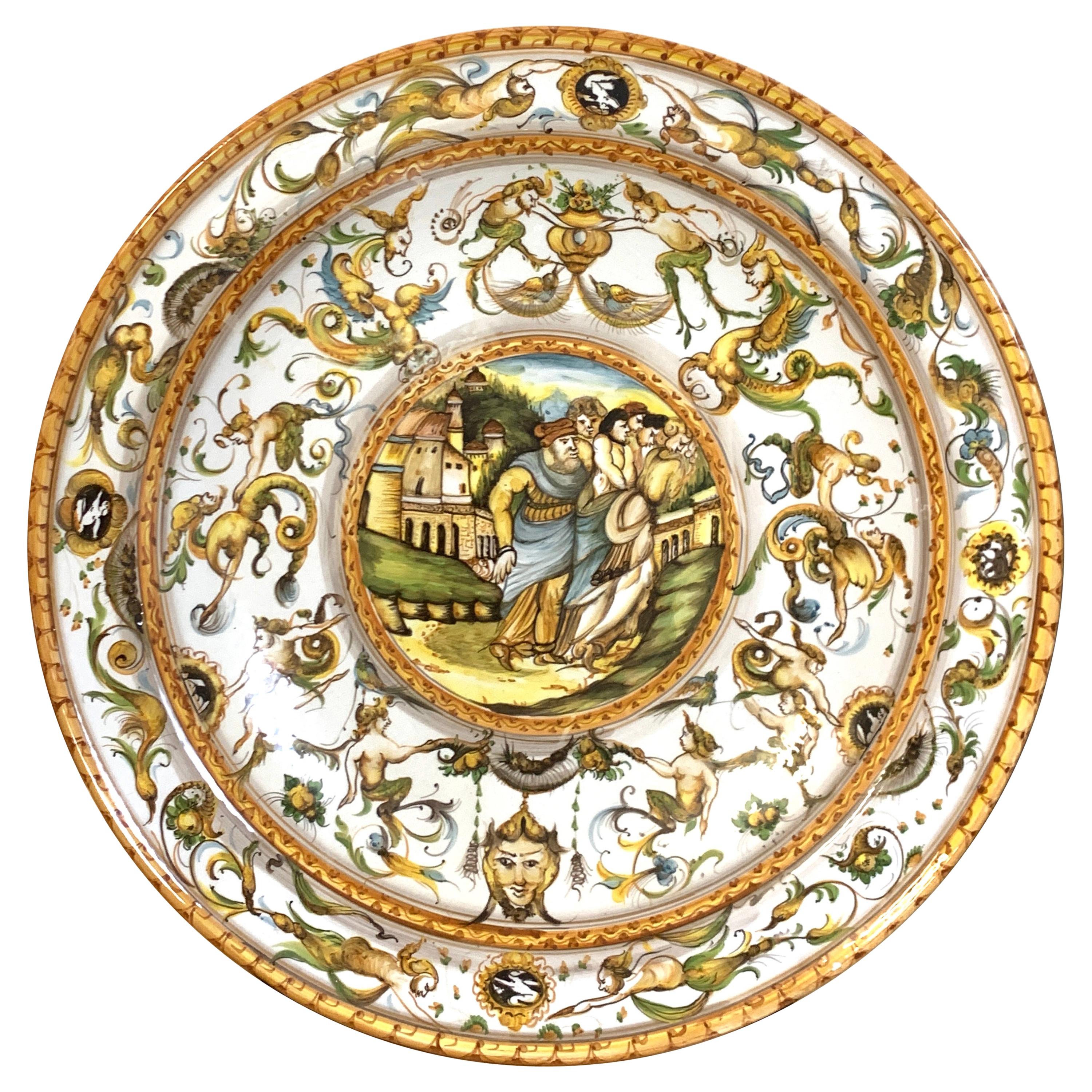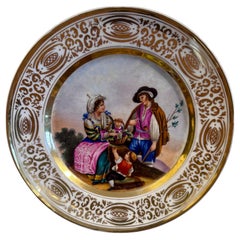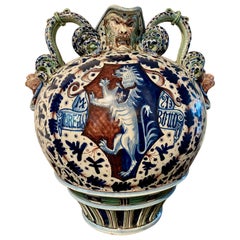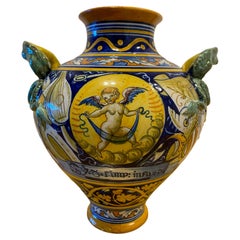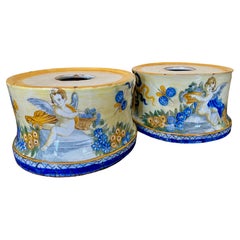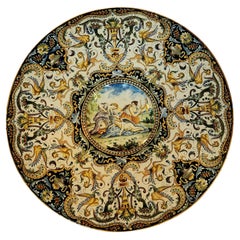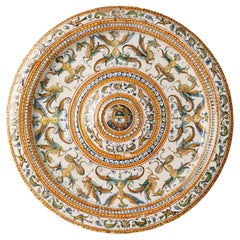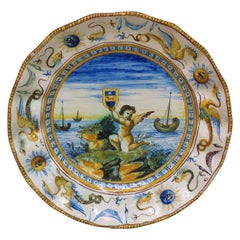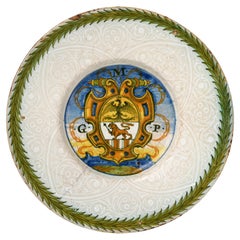Items Similar to Italian Cantagalli Maiolica Large Plate with family noble emblem, Late 19th C.
Want more images or videos?
Request additional images or videos from the seller
1 of 15
Italian Cantagalli Maiolica Large Plate with family noble emblem, Late 19th C.
$2,600
£1,974.24
€2,257.69
CA$3,632.58
A$4,040.22
CHF 2,109.68
MX$49,165.16
NOK 26,943.79
SEK 25,268.52
DKK 16,850.03
Shipping
Retrieving quote...The 1stDibs Promise:
Authenticity Guarantee,
Money-Back Guarantee,
24-Hour Cancellation
About the Item
Italian Cantagalli Maiolica Large Plate with family noble emblem, Late 19th Century
During the 19th century Renaissance-Revival period the Cantagalli Maiolica and ceramic factory near Florence produced authentic copies of Renaissance Maiolica using traditional methods of tin glazing earthenware.
This large Maiolica plate from the late 1800s is marked on the back with the symbol of the Rooster, which indicates that it was created by the Cantagalli ceramics factory. The plate is decorated in the center with the noble emblem of the house of Frederick Stibbert, a well-known late 19th century English/Italian collector of ancient weapons and ceramics, based in Florence. The inner rim of the plate is decorated with Raffaelesque motifs, naturally on a white background. Finally, the outer rim of the plate is decorated with Grotesques on a cobalt blue background.
- Creator:Cantagalli (Maker)
- Dimensions:Height: 1.5 in (3.81 cm)Diameter: 18.9 in (48.01 cm)
- Style:Renaissance Revival (Of the Period)
- Materials and Techniques:
- Place of Origin:
- Period:
- Date of Manufacture:1880
- Condition:Wear consistent with age and use.
- Seller Location:CH
- Reference Number:1stDibs: LU977836105822
About the Seller
5.0
Recognized Seller
These prestigious sellers are industry leaders and represent the highest echelon for item quality and design.
1stDibs seller since 2013
42 sales on 1stDibs
Typical response time: 1 hour
- ShippingRetrieving quote...Shipping from: Bissone, Switzerland
- Return Policy
Authenticity Guarantee
In the unlikely event there’s an issue with an item’s authenticity, contact us within 1 year for a full refund. DetailsMoney-Back Guarantee
If your item is not as described, is damaged in transit, or does not arrive, contact us within 7 days for a full refund. Details24-Hour Cancellation
You have a 24-hour grace period in which to reconsider your purchase, with no questions asked.Vetted Professional Sellers
Our world-class sellers must adhere to strict standards for service and quality, maintaining the integrity of our listings.Price-Match Guarantee
If you find that a seller listed the same item for a lower price elsewhere, we’ll match it.Trusted Global Delivery
Our best-in-class carrier network provides specialized shipping options worldwide, including custom delivery.More From This Seller
View AllItalian Paris Porcelain Painted Plate, Naples Circa 1825
Located in CH
Italian Paris Porcelain Painted Plate, Naples Circa 1825
During the late 1700s in Naples, King Ferdinand IV hired 2 well-known painters Alessandro D'Anna and Saverio della Gatta to ...
Category
Antique Early 19th Century Italian Restauration Porcelain
Materials
Porcelain
Cantagalli Armorial Vase, Ulisse Cantagalli, circa 1890
By Cantagalli
Located in CH
Cantagalli Armorial Vase, Ulisse Cantagalli (1839-1901)
During the 19th century Renaissance-Revival period the Cantagalli Maiolica and Ceramic Fac...
Category
Antique 1890s Italian Renaissance Revival Ceramics
Materials
Maiolica
Italian Cantagalli Polychrome Majolica Vase, Late 19th Century
By Cantagalli
Located in CH
Italian Cantagalli polychrome majolica vase, late 19th century
During the 19th century Renaissance-Revival period the Cantagalli Majolica and ce...
Category
Antique Late 19th Century Italian Renaissance Revival Vases
Materials
Faience
Italian Castelli Majolica Bases, circa 1800
By Castelli
Located in CH
Italian Castelli majolica bases, Circa 1800.
This pair of bases for large vases are a typical example of the high quality manufacturing of the Caste...
Category
Antique 19th Century Italian Rococo Pottery
Materials
Ceramic
Meissen Charger with Decoration a Flower Bunches, Marcolini Period Ca. 1800
By Meissen Porcelain
Located in CH
Meissen charger with decoration a flower Bunches, Marcolini period Ca. 1800
This large Meissen Charger is decorated with a stylized bouquets of flower...
Category
Antique 1790s German Neoclassical Porcelain
Materials
Porcelain
Italian Venetian Murano Renaissance Revival Very Large Glass Charger, circa 1910
Located in CH
Italian Venetian Murano Renaissance Revival very large glass charger, circa 1910
This glass charger of exceptional size and quality is an origina...
Category
20th Century Italian Renaissance Revival Glass
Materials
Art Glass, Blown Glass
You May Also Like
A Large Italian Maiolica Charger, 19th Century
Located in CABA, AR
Maiolica chargers are large, decorative ceramic plates that are part of the broader tradition of Maiolica pottery, a type of tin-glazed earthenware produced in Italy since the Renais...
Category
Antique 19th Century Italian Renaissance Revival Ceramics
Materials
Ceramic
$4,800 Sale Price
20% Off
Italian Renaissance Plate, Patanazzi Workshop Urbino, End of 16th Century
By Patanazzi Workshop
Located in Milano, IT
Acquareccia plate
Patanazzi workshop
Urbino, last quarter of the 16th century
It measures diameter 17.12 in; foot diameter 11.53 in; height 1.88 in (43.5 cm; 29.3 cm; 4.8 cm).
Weight
State of conservation: wear and a few small minimal detachments of enamel, chipping on the raised areas, peeling of enamel at the brim on the back.
This large, shallow basin is equipped with a wide and convex well. It is umbonate with a contoured center. The brim, short and flat, is enclosed in a double rounded and barely raised edge. The basin has a flat base without rims; it has a slightly concave center in correspondence to the well.
The shape takes inspiration from the basins associated with the metal forged amphora pourers that traditionally adorned the credenza. These were used from the Middle Ages to wash hands during banquets. Two or three people washed their hands in the same basin and it was considered an honor to wash one’s hands with an illustrious person.
The decoration is arranged in concentric bands with, in the center of the umbo, an unidentified shield on a blue background: an oval banded in gold with a blue head, a gold star and a field with a burning pitcher.
Rings of faux pods separate the center from a series of grotesque motifs of small birds and masks. These go around the basin and are, in fact, faithfully repeated on the brim. The main decoration develops inside the flounce of the basin, which sees alternating symmetrical figures of winged harpies and chimeras. The ornamentation, outlined in orange, green and blue, stands out against the white enamel background.
This decorative style, defined since the Renaissance as “grottesche” or “raffaellesche”, refers to the decorations introduced after the discovery of the paintings of the Domus Aurea towards the end of the fifteenth century. The discovery of Nero's palace, buried inside Colle Oppio by damnatio memoriae, occurred by chance when a young Roman, in 1480, fell into a large crack which had opened in the ground on the hill, thus finding himself in a cave with walls covered with painted figures.
The great artists present in the papal city, including Pinturicchio, Ghirlandaio, Raffaello, immediately visited these caves. The decorations found there soon became a decorative subject of immense success: the term grotesque , with the meaning of “unusual,” “caricatured,” or “monstrous,” was later commented by Vasari in 1550 as “una spezie di pittura licenziose e ridicole molto”( “a very licentious and ridiculous kind of painting”).
The decorations “a grottesche” also widely circulated in ceramic factories, through the use of engravings, variously interpreted according to the creativity of the artists or the requests of the client.
Our basin is reflected in similar artifacts produced at the end of the sixteenth century by the factories of the Urbino district. See the series of basins preserved in the main French museums, among which the closest in morphology is that of the Campana collection of the Louvre (Inv. OA1496); this however has a more complex figure decoration, while the decoration of our specimen is sober and with a watercolor style.
The style, sure in its execution, approaches decorative results still close to the works produced around the middle of the sixteenth century by the Fontana workshop. The decoration is closely linked to their taste, which later finds its natural outlet, through the work of Antonio, also in the Patanazzi workshop. Studies show the contiguity between the two workshops due to the kinship and collaboration between the masters Orazio Fontana and Antonio Patanazzi, both trained in the workshop of Guido Fontana il Durantino. It is therefore almost natural that their works, often created according to similar typologies and under the aegis of the same commissions, are not always easily distinguishable, so much so that the presence of historiated or “grottesche” works by Orazio is documented and preserved in Antonio Patanazzi's workshop. Given that the studies have always emphasized the collaboration between several hands in the context of the shops, it is known that the most ancient “grottesche” works thus far known, can be dated from 1560, when the Fontana shop created the so-called Servizio Spagnolo (Spanish Service) and how, from that moment on, this ornamentation became one of the most requested by high-ranking clients. We remember the works created for the Granduchi di Toscana, when Flaminio Fontana along with his uncle Orazio supplied ceramics to Florence, and, later, other commissions of considerable importance: those for the service of the Duchi d’Este or for the Messina Farmacia of Roccavaldina, associated with the Patanazzi workshop when, now after 1580, Antonio Patanazzi began to sign his own work.
Thus, in our basin, the presence of masks hanging from garlands, a theme of more ancient memory, is associated in the work with more advanced stylistic motifs, such as the hatching of the chimeras and harpies. These are found here on the front with the wings painted in two ornate ways. In addition, the theme of the birds on the edge completes the decoration along the thin brim and can be seen as representing an early style typical of the Urbino district during a period of activity and collaboration between the two workshops. Later, a more “doll-like” decorative choice, typical of the end of the century and the beginning of the seventeenth century, characterized the period of the Patanazzi workshop under the direction of Francesco.
Bibliography:
Philippe Morel, Il funzionamento simbolico e la critica delle grottesche nella seconda metà del Cinquecento, in: Marcello Fagiolo, (a cura di), Roma e...
Category
Antique 16th Century Italian Renaissance Ceramics
Materials
Maiolica
Deruta Maiolica Moulded Plate Probably 19th Century
Located in Ottawa, Ontario
A DERUTA MAIOLICA MOULDED PLATE
Probably 19th Century.
Painted with kneeling Cupid on a rock holding a heraldic shield surrounded by a seascape with...
Category
Antique Late 19th Century Italian Renaissance Contemporary Art
Materials
Tin
Small Maiolica Plate, Urbino District, 1533-1555
Located in Milano, IT
Maiolica plate (tondino)
Urbino district, Casteldurante or Pesaro, 1533-1555
It measures: diam. 7.48 in (19 cm), foot diam. 2.75 in (7 cm), height 1.0...
Category
Antique 16th Century Italian Renaissance Ceramics
Materials
Maiolica
Large Neo-Renaissance Italian Faience Platter Circa 1930
Located in Austin, TX
Large Neo-Renaissance Italian Faience Platter Circa 1930.
Category
Vintage 1930s English Renaissance Revival Platters and Serveware
Materials
Ceramic, Faience
Massive Italian Majolica Allegorical Charger by A. Deruta
By Deruta
Located in West Palm Beach, FL
Massive Italian Majolica allegorical charger by A. Deruta
Gorgeous continuous Italian Renaissance style decoration
Ready to hang.
Category
20th Century Italian Renaissance Ceramics
Materials
Majolica
$2,200 Sale Price
20% Off
More Ways To Browse
Italian Renaissance Plates
Rooster Plate
Ancient Weapon
Large Ceramic Rooster
Antique Cantagalli
Italian Ceramic Rooster
Cloutier Ceramics
Davenport Longport
Ironstone Cup
Japanese Ceramic Mugs
Kronjyden Denmark
Moulins Des Loups
Pair Masons Ironstone
Rose Canton Bowl
Vallauris Innocenti
Victoria Ware Ceramic
Antique Pie Mold
Blue Willow Japan
